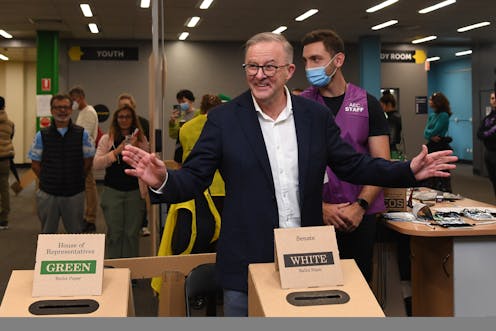Source: The Conversation (Au and NZ) – By Adrian Beaumont, Honorary Associate, School of Mathematics and Statistics, The University of Melbourne

AAP/Lukas Coch
With 53% counted at Saturday’s federal election, the ABC is calling 72 of the 151 House of Representatives seats for Labor, 52 for the Coalition, two Greens and nine Others. 16 seats remain in doubt.
Primary votes were 35.3% Coalition (down 6.2% since the 2019 election), 31.9% Labor (down 1.4%), 12.4% Greens (up 2.0%), 5.1% One Nation (up 2.0%), 4.4% UAP (up 1.0%) and 10.9% for all Others (up 2.6%). Labor is projected to win the two party vote by a 51.2-48.8 margin, a 2.7% swing to Labor.
The Poll Bludger’s model has 69 Labor wins to 47 for the Coalition. When seats where a party is ahead are assigned, Labor has 77, the Coalition 60, independents 10 and Greens three. That would put Labor just above the 76 needed for an outright majority. The Poll Bludger’s two party projection is 52.3-47.7 to Labor.
If Labor wins a majority, they can thank WA. Usually one of the most anti-Labor states at federal elections, the Poll Bludger currently has a 55.2-44.8 Labor two party win there, a 9.8% swing to Labor. Labor is ahead in ten WA seats to four for the Liberals with one independent.
In inner city seats, the Liberals will likely lose Treasurer Josh Frydenberg’s Kooyong (Vic), Goldstein (Vic), Higgins (Vic), North Sydney (NSW), Wentworth (NSW), Ryan (Qld) and Brisbane (Qld). However, Higgins was the only clear Labor gain, with the rest either going to independents or the Greens. Labor has likely lost Griffith to the Greens and Kristina Keneally’s Fowler to an independent.
I will have more tomorrow morning about the Senate and close House contests.
The results are an indictment on both major parties. Owing to the education divide, the Coalition lost support in wealthy urban seats, but it was the Greens and independents who gained, not Labor. The Coalition probably lost these seats owing to Scott Morrison’s record on climate change, and because of increasing education polarisation.
Read more:
Will a continuing education divide eventually favour Labor electorally due to our big cities?
Inflation is another key reason the Coalition lost this election. The 12-month inflation rate to the March quarter of 5.1% combined with the 2.4% rise in nominal wages meant that real wages fell 2.7% in those 12 months, and were down 2.2% since the 2019 election.
Read more:
Newspoll and Ipsos both give Labor clear leads in final polls; counting of early votes
Without this large fall in real wages, the Coalition would have been likely to offset losses in wealthy urban seats with gains from Labor in regional and outer suburban seats. It’s an indictment on Labor that voters didn’t turn to it.
The final two party vote will not be available for weeks as the electoral commission will not start a two party count in seats that were not contests between Labor and the Coalition until the main business of deciding elected members is over.
But with both major parties slumping, the best final pollster of the election was the Resolve poll for Nine newspapers that had primary votes of 34% Coalition, 31% Labor, 14% Greens, 6% One Nation, 4% UAP, 6% independents and 4% others.
Read more:
Labor’s lead narrows in three new national polls; and seat polls galore
More to come
![]()
Adrian Beaumont does not work for, consult, own shares in or receive funding from any company or organization that would benefit from this article, and has disclosed no relevant affiliations beyond their academic appointment.
– ref. Labor to form government as both major parties’ primary votes slump – https://theconversation.com/labor-to-form-government-as-both-major-parties-primary-votes-slump-183111







